Related Research Articles

Lieutenant General James Gordon Roudebush, USAF, was the 19th Surgeon General of the United States Air Force, Headquarters U.S. Air Force, Washington, D.C. General Roudebush served as functional manager of the U.S. Air Force Medical Service. In this capacity, he advised the Secretary of the Air Force and Air Force Chief of Staff, as well as the Assistant Secretary of Defense for Health Affairs on matters pertaining to the medical aspects of the air expeditionary force and the health of Air Force people. General Roudebush had authority to commit resources worldwide for the Air Force Medical Service, to make decisions affecting the delivery of medical services, and to develop plans, programs and procedures to support worldwide medical service missions. He exercised direction, guidance and technical management of more than 42,400 people assigned to 74 medical facilities worldwide.
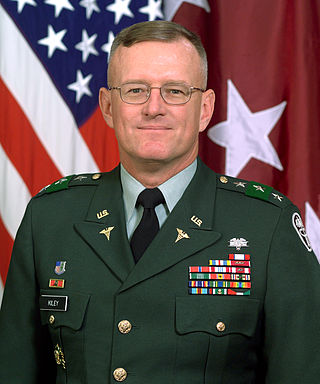
Kevin Christopher Kiley is a former lieutenant general in the United States Army who served as the 41st Surgeon General of the United States Army and the commander of the U.S. Army Medical Command, Fort Sam Houston, Texas. He was commander of Walter Reed Army Medical Center and North Atlantic Regional Medical Command twice, from 2002 to 2004, and as acting commander, March 1–2, 2007. He submitted his request to retire from the U.S. Army on March 11, 2007, in the wake of the Walter Reed Army Medical Center neglect scandal, and was removed from his nominative billet as a lieutenant general. Pending retirement, he was assigned to a temporary billet at the General Officer Management Office at the Pentagon in the grade major general. His retirement in the grade of major general was subsequently approved.

Major General Kenneth Lloyd Farmer Jr. commanded Walter Reed Army Medical Center and North Atlantic Regional Medical Command from June 2004 to August 2006.

Lieutenant General George Peach Taylor Jr. USAF (Ret.) was the 18th Surgeon General of the United States Air Force, Headquarters U.S. Air Force, Washington, D.C. General Taylor served as the senior Air Force officer responsible for comprehensive management of the Air Force Medical Service. In this capacity, he advises the Secretary of the Air Force and Air Force Chief of Staff, as well as the Assistant Secretary of Defense for Health Affairs, on matters pertaining to the medical aspects of the air expeditionary force and the health care of 2.6 million Air Force beneficiaries. The Surgeon General has authority to commit resources for the Air Force Medical Service, to make decisions affecting the delivery of medical services, and to develop plans, programs and procedures to support worldwide medical service missions. The Surgeon General exercises direction, guidance and technical management of more than 42,000 people assigned to 74 medical treatment facilities worldwide. From September 7, 2010 – December 22, 2010 he served as the acting Assistant Secretary of Defense for Health Affairs

Charles H. Roadman II was the 16th United States Air Force Surgeon General (1996–1999), Headquarters U.S. Air Force, Bolling Air Force Base, Washington, D.C. His father, Charles H. Roadman (1914–2000), was also an Air Force flight surgeon and command pilot.

Lieutenant General (Dr.) Edgar Ratcliffe Anderson Jr. was the 15th Surgeon General of the United States Air Force, Headquarters U.S. Air Force, Bolling Air Force Base, Washington D.C.

Charles Bruce Green is a retired lieutenant general in the United States Air Force and was the twentieth Surgeon General of the United States Air Force.

Robert A. Buethe is a retired major general and former Acting Surgeon General of the United States Air Force.
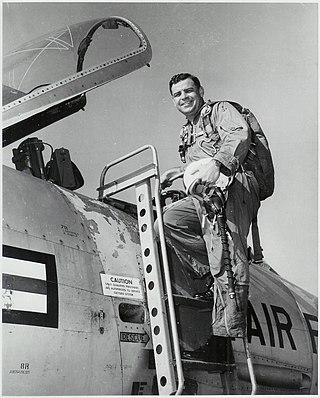
Warren L. Carpenter was a veteran of the United States Marine Corps and the Air Force, including serving as the Department of Defense's Chief Medical Officer for military space shuttle missions, flying 297 combat hours, serving as one of six Residents in Aerospace Medicine selected to fly on medical evacuation aircraft to bring home the U.S. prisoners-of-war from North Viet Nam on the final repatriation leg of Operation Homecoming, and earning six Service awards for marksmanship.
Franklin J. Blaisdell is a retired major general in the United States Air Force.

Fred F. Castle Jr. is a retired brigadier general in the United States Air Force Reserve Command.

John W. Doucette is a retired brigadier general of the United States Air Force (USAF).

Robert C. Hinson is a retired lieutenant general in the United States Air Force.
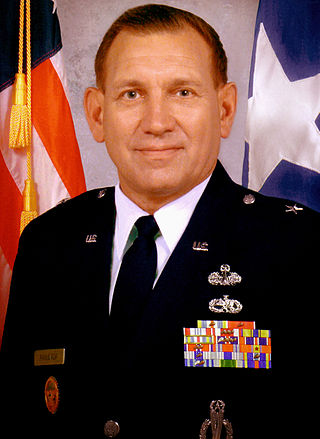
J. Gregory Pavlovich is a former brigadier general in the United States Air Force he joined in 1975 and retired in 2005. After being assigned to units within Europe he returned to the United States, and became executive program director in the Office of the Inspector General, U.S. Department of Defense. In 1994, he was named chief of strategic planning and business process integration at the Defense Logistics Agency. The following year, he became assistant executive director of the Readiness Group. In 1998, he became the vice commander of the 341st Space Wing. He assumed command of the wing later that year. In 2000, he was assigned to Air Force Space Command as deputy director of operations. He became commander of the 45th Space Wing at Patrick Air Force Base.
Theodore C. Almquist was a brigadier general in the United States Air Force.
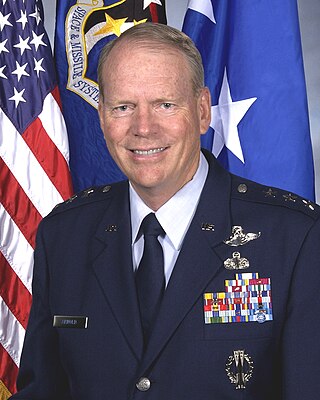
Brian A. Arnold is a former lieutenant general in the United States Air Force.

George E. Schafer was a lieutenant general in the United States Air Force who served as surgeon general of the United States Air Force from 1975 to 1978.

Monte Baldwin Miller was a lieutenant general in the United States Air Force who served as surgeon general of the United States Air Force from 1988 to 1991.
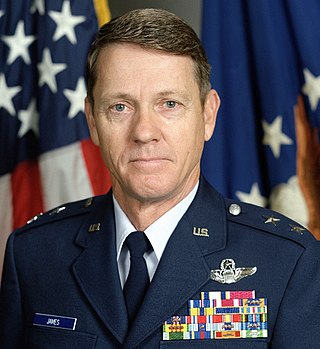
Major General William K. James of United States Air Force, was director of the Defense Mapping Agency (DMA) between June 1990 and June 1993. Under his leadership Major General James redirected the DMA – a heritage organization of the National Geospatial-Intelligence Agency – from producing products to meet the requirements of the Cold War to a concept of a Global Geospatial Information System (GGIS) directly accessible to combat commanders of the Rapid Deployment Forces. The GGIS was a major paradigm shift in warfare with the delivery of geographic information to fast-moving military forces.

Clinton Forrest Faison III is a retired vice admiral (VADM) in the United States Navy. He served as an officer in the Medical Corps and as the 38th Surgeon General of the United States Navy, and is currently the interim Provost of Northeast Ohio Medical University.
References
- ↑ "George K. Anderson". Military Times.com. Archived from the original on 2013-11-25. Retrieved 2013-06-05.
- ↑ "Major General (Dr.) George K. Anderson". United States Air Force. Archived from the original on 2013-06-02. Retrieved 2013-06-05.